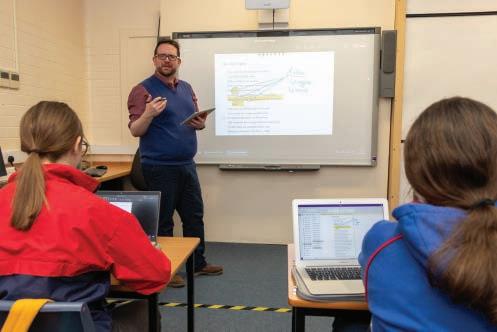
2 minute read
Looking forward
Looking to the future : e-learning at St George’s by Andy Leask
There were already a lot of exciting, creative things happening with technology in school. Virtual and Augmented Reality tech was bringing learning alive for students; audio and video technology was being used by teachers to enhance learning and teaching, and by students to demonstrate their learning.
Coronavirus – and the move to distance learning – undoubtedly accelerated things, however. In the space of a very short time we all (staff, students and parents) had to learn a lot. How to communicate with each other, remotely. How to teach remotely. How to assess remotely. How to look after the wellbeing of our students, our colleagues and ourselves. But learn a lot we did! The response to distance learning has been nothing short of amazing, and I feel proud of how positively everyone in the community
embraced the changes, faced the challenges head on, and pulled together.
And out of this crucible, many positives have been forged. Necessity, the mother of invention, inspired us to explore new, creative ways to communicate with one another. The creativity demonstrated by our students was remarkable. Freed from the constraints of a classroom, we saw and heard stories being told, principles demonstrated, theories tested, experiments conducted. Flipping the classroom – always an aspiration – became an absolute necessity, as we reevaluated how to make the best use of the limited contact time we had with our classes. And for older students, the control over assignments, deadlines and calendars was a real boon; not as much fun as dressing up as a pirate for Remove video lessons, perhaps, but every bit as impactful as students and staff alike learned to manage workloads.
So, what does the future hold? What lessons have we learned from lockdown, that we can take forward into 2021 and beyond?
There are obvious parallels with the wider world, for starters. The 21st Century workplace was changing anyway, but the dramatic increase in working remotely has accelerated the process. Many experts suggest that there will be a continued, permanent move in this direction, and so the skills of working and communicating remotely – using software like Teams, Outlook and other Office apps and making better use of multimedia resources to produce and consume content – have become more important than ever. Just as we bear a collective responsibility to support the development of numeracy and literacy in the young people we teach, we must also strive to build their digital literacy.
Technology also empowers us as educators to enhance the efficiency and efficacy of our teaching. Perhaps the single biggest step in this direction has been the move to a BYOD (Bring Your Own Device) policy in the Upper School; this immediately unlocks many practical benefits of technology for teachers and students. Digital textbooks. Audio feedback from teachers. Accessing, producing, and sharing class notes. Collaborating with peers – even at a social distance!
Technology advances at a great rate: while it’s important we don’t turn our backs on tradition, we owe it to our students to embrace these changes, and empower them to navigate the digital landscape that lies before them. It’s impossible to know exactly what the future will look like. But we’re excited to find out.











